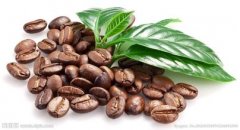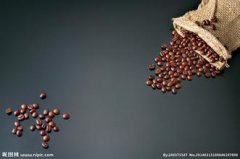A brief introduction to the cultivation of Yellow Bourbon Coffee beans in Brazil

"Sandoz" comes from PORTO DE SANTOS, a port in the Atlantic Ocean in southeastern Brazil. Among the coffee exported from Santos Port, there are Brazilian coffee from different producing areas, among which Minas Gerais is the best. The "bourbon" in Brazil Bourbon Santos comes from BOURBON Island of Bourbon Inambek Coffee Tree, which is now LA RUNION. Used to be the thriving place of Arabica coffee, Arabica coffee trees grown on the island have been introduced all over the world, Brazil Bourbon Santos is their descendant, Brazil is the world's largest coffee producer, known as the "coffee country". Italian espresso (ESPRESSO), commonly drunk around the world, is usually brewed with Brazilian coffee, which sometimes accounts for 90% or more of ESPRESSO. Brazil grows many kinds of coffee, and most of them are not of high quality, but there are also some world-famous products. One of them is the Brazilian bourbon Santos (BRAZIL BOURBON SANTOS), a seemingly complex name that sums up the history of this coffee.
Old bourbon coffee is grown on some estates in the Serrado district of Minas Greais state in southeastern Brazil. Old varieties of bourbon coffee grown on these estates, such as Capin Branco and Vista Allegre, are also sold on the market. Although they come from the same area, these coffees have their own characteristics. Capingblanco coffee is smoother than Vesta Allegre coffee, while Vesta Allegre coffee is strong and black, both of which have lower acidity. However, like all Brazilian coffee, they are most suitable for drinking when they are fresh and tender, because the older they are, the more acidic they are. These coffee growers have organized themselves into the Brazilian Special Coffee Association (the Speciality Coffee Association of Brazil).
Including all coffee beans grown in Brazil, except for Santos, Brazilian beans are mostly "cheap and good" coffee. Can be used for mass production of comprehensive coffee beans, most of which are re-roasted. The main raw material of instant coffee is also Brazilian coffee beans. When the coffee bean germ is very fresh, it is artificially refined and naturally dried in the vulva for about 60-70 days, so that the sweetness of the pulp fully infiltrates into the bean. Features: coffee beans have a strong aroma, moderate bitterness, high texture acidity, soft overall taste, low acidity and endless aftertaste. The taste of Brazilian coffee has a low sour taste, with the sweet and bitter taste of coffee, the entrance is very smooth, but also with a hint of grass aroma, slightly bitter in the fragrance, smooth and smooth, with a pleasant aftertaste. There are no outstanding advantages for Brazilian coffee, but there are no obvious drawbacks, such as mild and smooth taste, low acidity and moderate mellow.
Unlike in the past, Brazil's economy is now less dependent on coffee, which accounts for only 8% to 10% of GDP. Before World War II, Brazil accounted for 50% or more of the world's coffee production, and now it is close to 30%. But the country's impact on the world's coffee, especially on coffee prices, is significant. For example, two frost disasters in 1994 caused a sharp rise in global coffee prices.
Since the introduction of coffee trees from French Guiana (Guyana) in 1720, coffee production has gradually become a science. Before 1990, the Brazilian government carried out strict monitoring of the coffee industry, with both strict intervention and price protection measures, and the state has been implementing minimum price protection measures for farmers, resulting in coffee overproduction. Before World War II, the remaining stock reached 78 million bags, which had to be burned by fire or thrown into the water to destroy.
Coffee was first introduced to Brazil in the early 18th century. In 1727, the Brazilian government sent a personable army officer to secretly bring coffee seeds back to Brazil from French Gaiana under the pretext of mediating border disputes. It is said that the governor's wife of French Gayana was so fascinated by the officer that she secretly brought coffee tree seeds to him at a farewell dinner party. At present, 2 million hectares of land in Brazil is used to grow coffee, with the largest being Arabica. The beans will eventually be sent to the big bakers in various countries, known as Santos (in the name of the port of export, santos, not the producing area).
In addition, Mogiana in the northeast of Sao Paulo Province (north to South Minas) is also dominated by shaded bourbon, which is ranked as the three major boutique producing areas in Brazil along with Serrado and South Minas. Well-known estates in South Minas include Hope Manor and Montague. The famous "Datra Manor" and "Highland Manor" groups also have several large estates in Serrado and Mojiana. The winning estates of the four cup tests have become the treasures of the town shops of South Minas, Serrado and Mojiana.
In the first three or four years before the coffee tree began to bear fruit, the beans were small and curved, with excellent flavor, and became the "Bourbon Santos". After that, the beans became bigger, flat in shape, no longer bent, and became "flat bean Santos". The flavor was not as good as before. Brazilian coffee can be found everywhere in Taiwan, but most of them are flat bean Santos. In fact, there are still high-quality coffee beans in various parts of Brazil, which will be sold on the market under their own name and are no longer commonly known as "Brazilian coffee." Some farms still retain the old bourbon species, with small particles of raw beans, obvious bending, red silk on the central line and the nickname "red center". Bourbon beans taste full, strong aroma, like drinking old wine, it is well worth a try
Properly treated sun beans are rich in flavor and sweeter, but the sun is easy to have impurities and it is not easy to distinguish between unripe beans. When we choose beans, we usually buy and taste a small amount of beans before placing orders in large quantities, and then bake and taste a small amount of beans when the large quantities arrive, and then test the beans before and after the cup to determine whether the beans are of the same level this time.
[country of production]: Brazil (Brazil) [producing area]: Cerrado [Manor]: Chateau Bau (Fazenda Bau) [Variety]: yellow bourbon Yellow Bourbon [Grade]: NY.2 [growth altitude]: 1100-1200m [treatment]: solarization Natural
Hence the name of the port of Santos export In the first three or four years before the coffee tree began to bear fruit, the beans were small and curved, with excellent flavor, and became the "Bourbon Santos". After that, the beans became bigger, flat in shape, no longer bent, and became "flat bean Santos". The flavor was not as good as before. Brazilian coffee can be found everywhere in Taiwan, but most of them are flat bean Santos. In fact, there are still high-quality coffee beans in various parts of Brazil, which will be sold on the market under their own name and are no longer commonly known as "Brazilian coffee." Some farms still retain the old bourbon species, with small particles of raw beans, obvious bending, red silk on the central line and the nickname "red center". Bourbon beans taste full, strong aroma, like drinking old wine, it is well worth a try
There are no particular advantages for Brazilian bourbon Santos coffee, but there are no obvious drawbacks. This coffee has a mild and smooth taste, low acidity, moderate mellowness and a touch of sweetness. All these soft flavors are mixed together, and if you want to distinguish them one by one, it is the best test for the taste buds, which is why many fans love this kind of coffee, precisely because it is so mild and ordinary. Bourbon Santos is suitable for ordinary baking and brewing in the most popular way. It is the best raw material for making Italian espresso (ESPRESSO) and all kinds of fancy coffee.
Important Notice :
前街咖啡 FrontStreet Coffee has moved to new addredd:
FrontStreet Coffee Address: 315,Donghua East Road,GuangZhou
Tel:020 38364473
- Prev

Brazil fine coffee varieties planting market price profile
Moreover, the semi-solarization method also inherits the advantages of the solarization method to improve sweetness, but it has less unpleasant earthy taste, winning praise from international coffee experts. The winners of Brazil's Super Cup of National Beans almost all used the semi-sun method, because this treatment can reduce the traditional earthy and woody taste of Brazil beans, and enhance the fruity and sweet taste, which is most suitable for single products. Therefore, semi-sun method has become a must for Brazil's fine beans.
- Next

A brief introduction to the flavor, taste and aroma characteristics of Kenyan coffee manor
In addition to having obvious and charming fruit acidity, Kenyan coffee is mostly from small coffee farmers, planted in a variety of different environments, encounter different climate and rainfall every year, and bring a variety of distinct and unique personalities. Take the AAPlus grade KenyaAA+Samburu as an example, the 2001 Samburu has a strong black plum flavor, low acidity and strong taste, and was newly harvested in the winter of 2002.
Related
- Detailed explanation of Jadeite planting Land in Panamanian Jadeite Manor introduction to the grading system of Jadeite competitive bidding, Red bid, Green bid and Rose Summer
- Story of Coffee planting in Brenka region of Costa Rica Stonehenge Manor anaerobic heavy honey treatment of flavor mouth
- What's on the barrel of Blue Mountain Coffee beans?
- Can American coffee also pull flowers? How to use hot American style to pull out a good-looking pattern?
- Can you make a cold extract with coffee beans? What is the right proportion for cold-extracted coffee formula?
- Indonesian PWN Gold Mandrine Coffee Origin Features Flavor How to Chong? Mandolin coffee is American.
- A brief introduction to the flavor characteristics of Brazilian yellow bourbon coffee beans
- What is the effect of different water quality on the flavor of cold-extracted coffee? What kind of water is best for brewing coffee?
- Why do you think of Rose Summer whenever you mention Panamanian coffee?
- Introduction to the characteristics of authentic blue mountain coffee bean producing areas? What is the CIB Coffee Authority in Jamaica?

